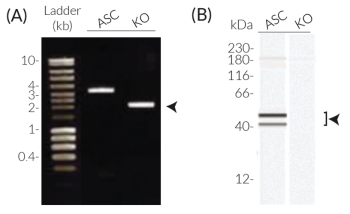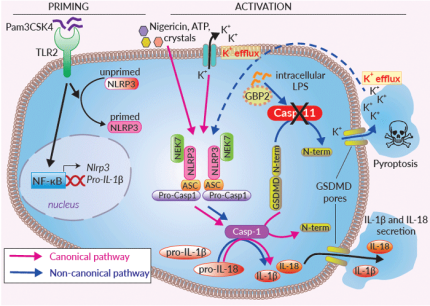RAW-ASC KO-CASP11 Cells
-
Cat.code:
raw-kocasp11
- Documents
ABOUT
Caspase-11 knockout in RAW 264.7 cells
Murine caspase-11 (CASP11) is an inflammatory caspase playing a crucial role in the non‑canonical inflammasome responses to intracellular lipopolysaccharide (LPS) [1-3].
InvivoGen has generated RAW-ASC KO-CASP11 cells from the RAW-ASC cell line, which derives from the naturally ASC deficient RAW 264.7 macrophage cell line [4]. RAW-ASC KO-CASP11 cells stably express the transfected murine ASC gene and have a stable knockout of the caspase-11 (CASP11) gene.
• RAW-ASC KO-CASP11 cells – Knockout (KO) of the CASP11 gene and expression of the murine ASC gene
The secretion of mature IL-1β is impaired in RAW-ASC KO-CASP11 cells upon activation of the non-canonical (caspase-11) inflammasome when compared to the parental cell line. However, this response is comparable to the parental RAW-ASC cells upon canonical inflammasome activation. This cell line is a useful tool to study the role of CASP11 in the inflammasome responses and is an alternative to the in vitro differentiation of mouse bone-marrow-derived macrophages.
FEATURES OF RAW-ASC KO-CASP11 CELLS:
- Verified biallelic knockout of the CASP11 gene and stable expression of the ASC gene (Western blot)
- Impaired mature IL-1β secretion after non-canonical inflammasome activation by LPS
- Alternative cellular assay to the in vitro differentiation of mouse bone-marrow-derived macrophages
![]() Download our Practical guide on Inflammasomes
Download our Practical guide on Inflammasomes
References:
1. Kayagaki N. et al., 2011. Noncanonical inflammasome activation targets caspase-11. Nature. 479:117.
2. Kayagaki N. et al., 2015. Caspase-11 cleaves gasdermin D for non-canonical inflammasome signalling. Nature. 526:666.
3. Shi J. et al., 2014. Inflammatory caspases are innate immune receptors for intracellular LPS. Nature. 514:187.
4. Pelerin P. et al., 2008. P2X7 receptor differentially couples to distinct release pathways for IL-1β in mouse macrophage. J. Immunol. 180:7147.
Disclaimer: These cells are for internal research use only and are covered by a Limited Use License (See Terms and Conditions). Additional rights may be available.
SPECIFICATIONS
Specifications
Inflammasome activation cellular assays
Complete DMEM (see TDS)
Verified using Plasmotest™
Each lot is functionally tested and validated.
CONTENTS
Contents
-
Product:RAW-ASC KO-CASP11 Cells
-
Cat code:raw-kocasp11
-
Quantity:3-7 x 10^6 cells
- 1 ml of Normocin™ (50 mg/ml). Normocin™ is a formulation of three antibiotics active against mycoplasma, bacteria, and fungi.
- 1 ml of Blasticidin (10 mg/ml)
Shipping & Storage
- Shipping method: Dry ice
- Liquid nitrogen vapor
Storage:
Details
CASP11 and its human orthologs CASP4 and CASP5 are "non-canonical inflammasomes" that sense intracellular lipopolysaccharide (LPS) from Gram-negative bacteria and cause inflammatory responses, independently of TLR4 [1-3]. In the context of bacterial infection, LPS can be released from lysed bacteria as “free” LPS aggregates or actively delivered to the host cell through the release of small spherical bodies that encapsulate many bacterial components (i.e. toxins, DNA, RNA, and LPS) termed outer membrane vesicles (OMVs).
CASP11 directly binds to the lipid A moiety of LPS, which features a variable number of acylated fatty acid chains depending on the bacterial strain [2,3]. Of note, CASP11 expression is weak in resting cells and can be induced through NF-κB or STAT1 activation [4]. CASP11 (and CASP4/5) cannot cleave pro-IL-1β and IL-18. However, they trigger the cleavage of the pore-forming protein gasdermin D (GSDMD), leading to the release of alarmins and K+ efflux. Ultimately, this induces the activation of NLRP3 and CASP1-mediated IL-1β/-18 maturation and secretion [3].
1. Kayagaki N. et al., 2011. Noncanonical inflammasome activation targets caspase-11. Nature. 479:117.
2. Kayagaki N. et al., 2015. Caspase-11 cleaves gasdermin D for non-canonical inflammasome signalling. Nature. 526:666.
3. Shi J. et al., 2014. Inflammatory caspases are innate immune receptors for intracellular LPS. Nature. 514:187.
4. Rathinam. et al., 2012. TRIF Licenses Caspase-11-Dependent NLRP3 Inflammasome Activation by Gram-Negative Bacteria. Cell. 150:606.
DOCUMENTS
Documents
Technical Data Sheet
Validation Data Sheet
Safety Data Sheet
Certificate of analysis
Need a CoA ?











